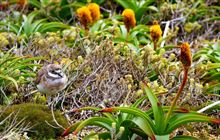DOC plans for Auckland Islands predator eradication
Archived content: This media release was accurate on the date of publication.
Introduction
DOC is progressing plans to eradicate introduced predators on the Auckland Islands in the subantarctic, Conservation Minister Maggie Barry says.Date: 21 July 2017 Source: Office of the Minister of Conservation
A specialist team has been established to develop a feasibility study for the total eradication of pigs, cats and mice from 50,000 ha Auckland Island, the largest in the subantarctic, which lies 465 km south of Bluff.
“A successful eradication would be a significant contribution to meeting our Predator Free 2050 target of wiping out predators on our offshore island nature reserves by 2025,” Ms Barry says.
“This will require careful and thorough planning, and will not be done in a day or even a year. The logistical difficulties of operating in the subantarctic cannot be underestimated. It is an extreme environment, at the utmost edge of New Zealand’s territory.
“That said, if anyone can do it, DOC can – New Zealand is justifiably recognised as a world leader in successfully eradicated predators from offshore islands. Stephen Horn, the team leader for this effort, project managed the recent successful Million Dollar Mouse eradication on Antipodes Island, also in the subantarctic.”
Pigs, cats and mice were introduced to Auckland Island in the early 19th century. These pests are responsible for decimating many species of bird on the island and continue to prey on chicks from species such as the endangered yellow-eyed penguin.
“Visiting the Auckland Islands in February, I saw first-hand the damage pigs have done to the foliage and habitat for sea lions as well as bird species like penguins and albatross,” Ms Barry says.
“Feral pigs have wiped out the flightless teal, snipe and rail, as well as all the burrowing seabirds. They have devastated the vegetation, megaherb fields and insect life, and they continue to harm the yellow-eyed penguin population.
“The feasibility study will give us a clear set of future options as we look to protect this UNESCO World Heritage Site for future generations.”
DOC intends to publish the feasibility study in February next year.
Contact
For media enquiries contact:
Email: media@doc.govt.nz

